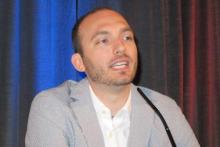WAIKOLOA, HAWAII – In light of the U.S. Preventive Services Task Force’s recent rejection of population-based melanoma screening in a draft recommendation, the future of skin examination for early detection of melanoma most likely lies in the development of a targeted, risk-stratified screening approach, Dr. Michael A. Marchetti said at the Hawaii Dermatology Seminar.
The logical place to start would be in white men above age 50. They account for 50% of all melanoma deaths in the United States. Thus, this is a group where melanoma screening is most likely to bring significant demonstrable benefit with the least potential harm, according to Dr. Marchetti, a dermatologist at Memorial Sloan Kettering Cancer Center in New York.
In its December 2015 draft recommendation statement, the USPSTF declared “current evidence is insufficient to assess the balance of benefits and harms of visual skin cancer screening in adults.” The panel drew the same conclusion in its previous 2009 assessment, Dr. Marchetti noted at the seminar provided by the Global Academy for Medical Education/Skin Disease Education Foundation.
Panelists did not find persuasive the German SCREEN study (Skin Cancer Research to Provide Evidence for Effectiveness of Screening in Northern Germany), which initially generated enormous excitement among skin cancer experts worldwide. SCREEN investigators triumphantly reported a 48% drop in mortality from melanoma 5 years after the German state of Schleswig-Holstein instituted a population-based skin cancer screening program based upon total body skin examination by dermatologists and specially trained primary care physicians (J Am Acad Dermatol. 2012 Feb;66[2]:201-11).
However, the SCREEN study has since come under a variety of criticisms. The USPSTF took note, and in its December update declared the study had “important methodologic limitations” which “raise questions as to the plausibility of the observed effect.” In a best case scenario, according to the panelists, the benefit of the Schleswig-Holstein melanoma awareness campaign and free screening program worked out to at most one fewer melanoma death per 100,000 persons screened annually over a decade.
Dr. Marchetti noted that the German federal government found the SCREEN program initial results so impressive that a national program of free biannual skin cancer screening for all adults age 35 and older has been adopted. Disappointingly, however, investigators at the International Prevention Research Institute in Lyon, France, have reported that in the first 5 years of the national program, melanoma mortality rates not only didn’t decrease, they actually increased by 2.6% in men and 0.02% in women. Moreover, the same investigators determined that in the second 5-year period of screening in Schleswig-Holstein, melanoma mortality rates shot back up to levels seen before initiation of the screening program (BMJ Open. 2015 Sep 15;5[9]:e008158).
Dr. Marchetti said that based upon his reading of the USPSTF 2009 and December 2015 reports, he doesn’t think the panel takes issue with the concept that earlier detection of melanomas while they are thinner results in a much better prognosis. Their major concern is with the scarcity of data regarding the potential harms involved in population-based skin cancer screening, which include the cost and morbidity of the enormous number of skin biopsies which would result from such a screening program, with most of those biopsies coming back negative.
He added that he shares those reservations.
“I have a lot of concern about targeting low-risk populations for screening, particularly children and adolescents and dark-skinned individuals. I think in those circumstances we’re more likely to have greater harm,” the dermatologist said.
Indeed, he and his coinvestigators recently analyzed two large dermatopathology databases and concluded that during 2009-2013 in the United States, 1,035 biopsies of nevi were performed in patients age 19 years or younger in order to find one melanoma (JAMA Dermatol. 2015 Apr;151[4]:447-8).
Dr. Marchetti also recently published a viewpoint article in which he asserted that increased pressure to detect acral lentiginous melanoma in dark-skinned individuals could lead to significant harms with minimal return benefit (JAMA Dermatol. 2015 Oct;151[10]:1055-6).
The December 2015 update from USPSTF was the group’s draft document, with the final recommendations forthcoming this year. The public comment period has closed, and no major professional organization in the United States – not the American College of Physicians, the American Academy of Family Physicians, or even the American Academy of Dermatology – specifically recommends a clinical visual skin cancer screening examination.
In response to an audience question, session chair Dr. Ashfaq A. Marghoob commented that the USPSTF’s stance has big implications for physician reimbursement for skin cancer screening examinations in patients who have no symptoms or aren’t already under surveillance due to high risk of skin cancer.


